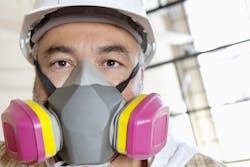Final Beryllium Rule Lowers Exposure Limit for Workers
In its final rule to protect workers from beryllium exposure, OSHA has reduced the PEL for beryllium to 0.2 micrograms per cubic meter of air, averaged over eight hours, and established a new short-term exposure limit for beryllium of 2.0 micrograms per cubic meter of air, over a 15-minute sampling period.
The final rule lowering the permissible exposure limit (PEL) for beryllium couldn’t come soon enough, according to safety industry advocates.
About 62,000 workers are exposed to beryllium during their work day, including 11,500 construction and shipyard workers, according to the agency.
Beryllium, either inhaled or through skin contact, contributes to an increased risk of lung cancer, chronic lung disease and various sudden on-set respiratory ailments among workers.
The final rule, which will take effect on March 10, has been issued 67 years after a beryllium PEL first was established, before the founding of OSHA.
"Outdated exposure limits do not adequately protect workers from beryllium exposure," said Dr. David Michaels, OSHA assistant secretary of labor. "OSHA's new standard is based on a strong foundation of science and consensus on the need for action, including peer-reviewed scientific evidence, a model standard developed by industry and labor, current consensus standards and extensive public outreach. The new limits will reduce exposures and protect the lives and lungs of thousands of beryllium-exposed workers."
OSHA adopted the limits set by the Atomic Energy Commission in its original beryllium rule 40 years ago. However, it wasn’t until 2002 that the agency first began seeking public comment to revise the standard. Rulemaking specialists visited work sites, performed risk assessments and calculated potential impacts on small businesses.
Ten years later, Materion Brush Inc., one of the country's primary beryllium manufacturers, joined the movement, issuing a joint draft statement with United Steelworkers (USW) addressing the need for change.
“Our cooperative efforts demonstrate that industry and labor can collaborate to protect workers and to protect jobs at the same time,” Materion CEO Richard Hipple previously said.
OSHA issued a proposed rule in 2015, and months of public comment and hearings followed, including input from industry and labor stakeholders, small business representatives, subject matter experts and partner agencies.
With lowered exposure standards, OSHA estimates it annually could prevent 94 deaths and 50 serious illnesses caused from exposure.
New Provisions
The majority of workers affected by this rule are exposed in general industry operations such as beryllium metal and ceramic production, non-ferrous foundries and fabrication of beryllium alloy products, according to the agency.
The new rule also requires employers to use engineering and work practice controls such as ventilation or enclosure, provide respirators when controls are not adequate, limit worker access to high-exposure areas, develop a written exposure control plan and train workers on beryllium hazards.
Companies also will now be required to make medical exams available to monitor exposed workers and provide medical removal protection benefits to workers identified with a beryllium-related disease, according to OSHA.
After the final rule takes effect, employers have until March 12, 2018 to comply with most of the requirements. All sectors have two years – or until March 2019 - to provide any required change rooms and showers and until March 2020 to implement engineering controls.
Worker Advocates React
Despite the wait, advocates of the rule are satisfied that permissible exposure limits finally have been lowered.
“While we are frustrated that the rule has taken so long to complete, we commend OSHA for issuing this lifesaving rule,” said Dr. Sammy Almashat, a researcher with Public Citizen’s Health Research Group. “Tens of thousands of workers will finally have the protections that they have lacked for far too much time.”
The policy watch group also collaborated with USW to push for lower PEL limits.
"This has been a long time in the making," said USW International President Leo W. Gerard. "The USW has advocated for an OSHA rule since the early 1970s. This rule will protect workers who are exposed to beryllium in general industry, construction and shipyards and ensure that controls are put in place to prevent future occupational illness from developing."
